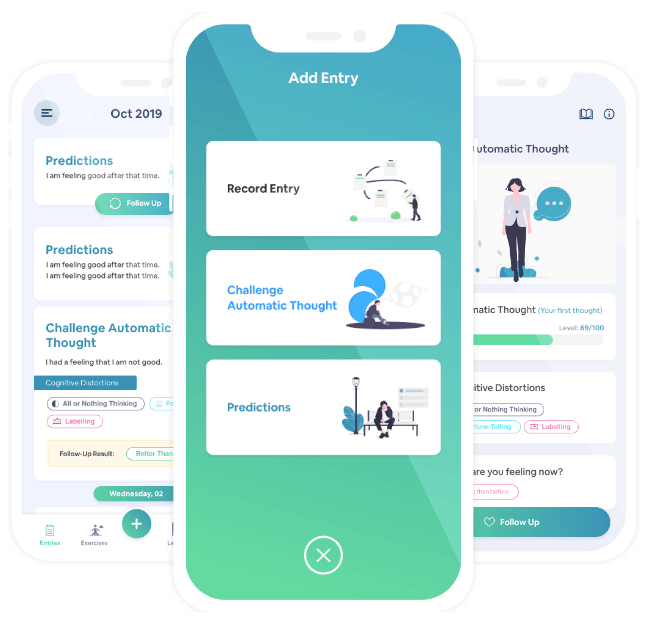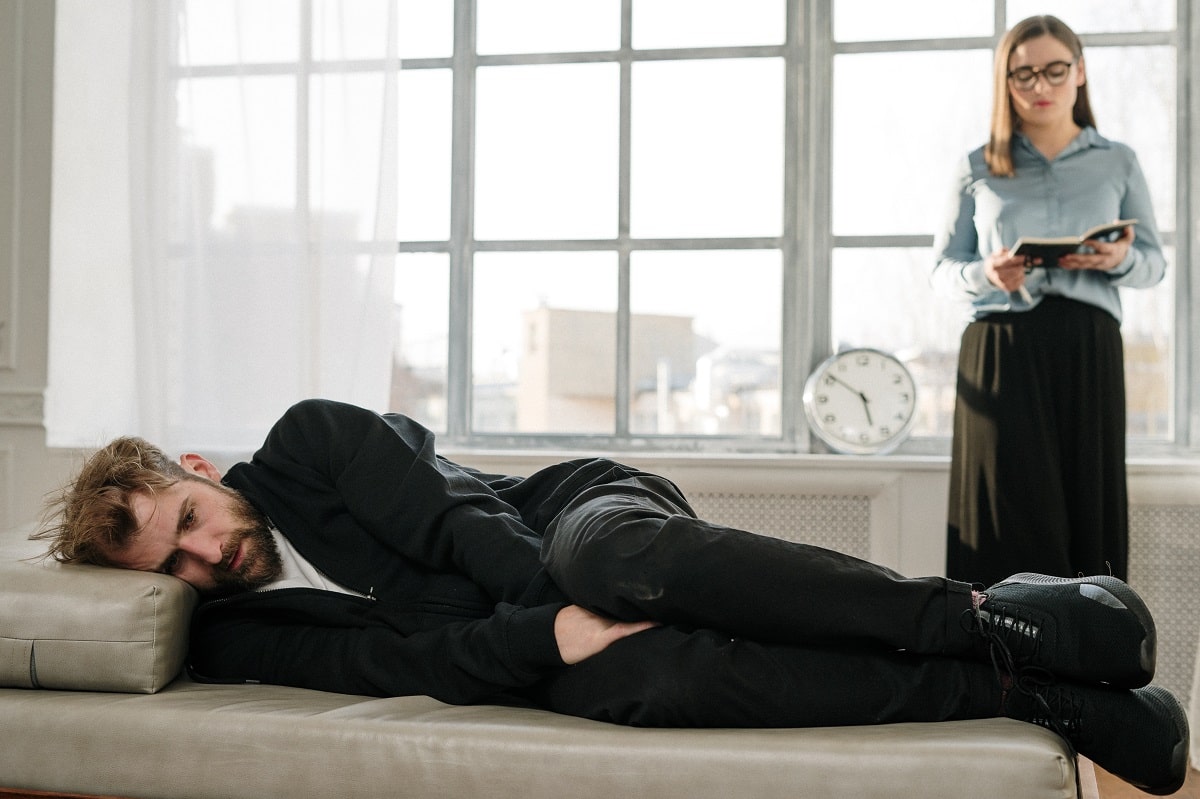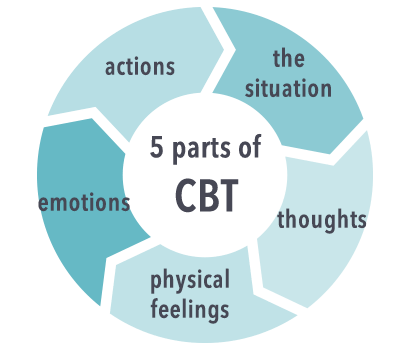Cognitive Behavior Therapy (CBT) is an evidence-based talk therapy approach that has successfully resolved numerous cognitive issues. The success of the treatment is dependent on the commitment made by the individual and their therapist to meet for a weekly hour-long therapy session.
One of the core principles of CBT is that thoughts and feelings are not determined by the situation but by the interpretation of the situation. Unhelpful behavior is often caused by faulty thoughts which in turn bring up false feelings and emotions. Hence if we can create positive thoughts around triggering events, we are successful in breaking this loop.
Determining the appropriate technique to be applied to a particular person is critical. For instance, Cognitive Behavior Therapy for anxiety is given to a person dealing with an anxiety disorder. The approach used varies from person to person. But the formulation of all the tools and techniques are based on a common foundation:
- Spot out the issue to be resolved.
- Ruling out the cause behind unhelpful behavior.
- Reframing the faulty thoughts.
- Introducing a new, positive emotional pattern in the person.
The type of Cognitive Behavior Therapy provided to an individual is determined by the therapist after a couple of communication sessions. The top 10 commonly used approaches for providing CBT are as follows-
1. Exposure Therapy
While providing Cognitive Behavior Therapy for social anxiety disorder, the person is made to fight his phobia. The therapist intentionally takes the individual to various public gatherings. There the person is then made to interact with people. This interaction is a part of their therapy. This duration of unmasking the person to the public is thereafter increased gradually. This technique helps increase confidence in facing society.
2. Relaxation Techniques
Cognitive Behavior Therapy for anxiety is provided only when the person is calm, else the conditions may get worse. This involves various relaxation techniques, like virtualization, breathing exercises, body loosening.
These techniques help in lowering down the stress level, enabling the person to fight their phobia, social anxiety disorder, and similar stress oriented disorders.

3. Self Indulgence Therapy
This technique is best suited for people suffering from depression where they build their own virtual world. While providing Cognitive Behavior Therapy, the therapist listens to the patient’s thoughts very closely and tries to take in their perception.
Thereafter, the therapist raises various questions for each thought and assumption and asks the person to prove them. Being altogether imaginary, the person fails to prove them and slowly starts believing what the therapist wants to show. This gradually starts bringing the person to a realistic world.
4. Experimental Therapy
Anxiety disorders can be resolved using experimental therapy. It is based upon a catastrophic thinking process, where the patient develops the tendency of fearing baseless catastrophes.
While providing CBT for anxiety, the anxiety level of the person is initially raised so that the individual starts claiming about the disasters, going to take place. The therapist believes them and waits for his forecast to come true. But when the predictions fail, the rate of thinking towards the same starts lowering in the person. As a result, his thought patterns are altered towards a more practical path.
5. Reframing Thoughts Pattern
Cognitive Behavior Therapy for depression involves reframing thoughts. This therapy works at the unconscious level of the person’s brain. The person’s feelings and thoughts are very closely heard by the therapist. With the constant acknowledgments from the therapist's side, the person starts developing a feeling of comfort and becomes relaxed when assured that someone understands their issues.
The therapist (in his/her acknowledgments) starts reframing the person’s thoughts in a positive way. This leaves a helpful impact at the unconscious level, making the person think in the way the therapist wants.
6. Scheduling And Activation
When a person is given Cognitive Behavior Therapy for anxiety, they are sometimes asked to pen down all the activities that need to be completed. Thereafter, schedule them in an orderly manner. This practice makes the individual relaxed and the level of anxiety is lowered thereof.
7. Homework
Homework is a critical component of CBT treatment. This keeps the individual connected to the sessions taken. The homework may comprise a list of questionnaires or activities, which widens up the brain and thinking capabilities of the person. This, in turn, helps bring them back to the practical world in a much more creative way.
8. Role Play
This technique is very helpful in making the person understand others' perspectives towards the same situation. This also helps reduce social phobia, improving communication and problem-solving skills, fighting back adverse situations, and also raises confidence levels.
9. The SOLVED Technique
This technique is effective to help people who are unable to gather confidence to face a situation. This technique works like a mantra for a person to overcome their phobias. As the name implies,
- S stands for making a selection of a proper issue that needs to be resolved.
- O stands for welcoming all possible solutions with an open mind.
- L stands for making a list of positives and negatives for every suggested solution.
- V stands for selecting and verifying the most appropriate available solutions.
- E stands for enacting upon the plan.
- D stands for making a firm decision towards the plan if it worked out successfully.
10. Journaling and Recording

In this technique, the person is asked to pen down each day’s thoughts (both the positive and the negative ones) emerging during and after each session of Cognitive Behavior Therapy. Reviewing and observing prominent thoughts helps to change behavioral patterns.
The core of Cognitive Behavior Therapy is the degree of comfort between the person and the therapist. If the person is unable to bond up with the therapist, it is advisable to get another one. No therapy works overnight. The wholehearted commitment of both, the person and the therapist are mandatory for positive results. The person should readily accept new thoughts and techniques. Some of the techniques (like exposure therapy) may raise the stress level at once, but it should be taken as a part of therapy.
CBT Companion

To assist the interaction between a therapist and the individual receiving therapy Swasth has developed a robust and feature-rich CBT Companion App.
The app helps track emotions, activities, negative thoughts, and homework assignments which can be shared with the therapist augmenting the experience of the therapy sessions. The app also provides user-friendly videos and animations enabling a quicker learning and longer retention attitude in the learners.



